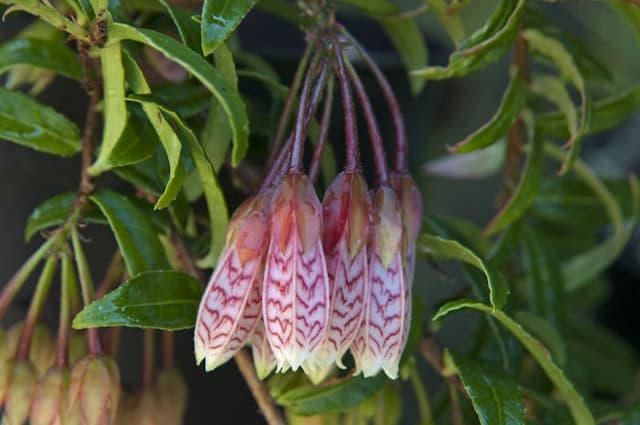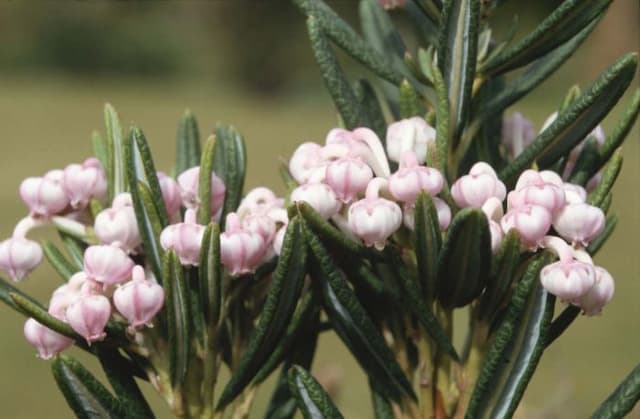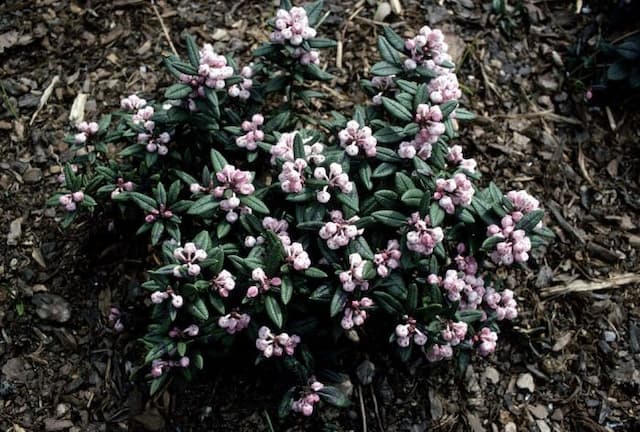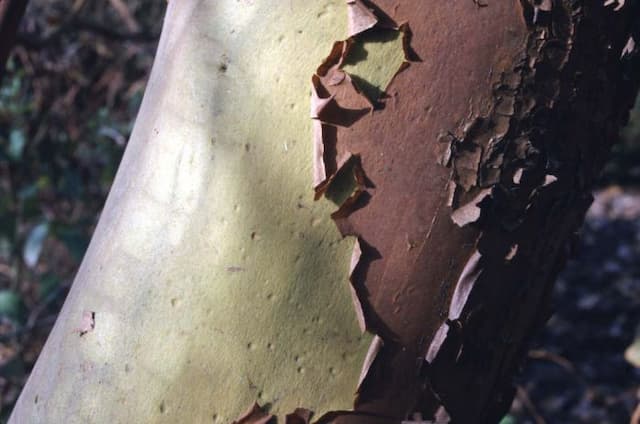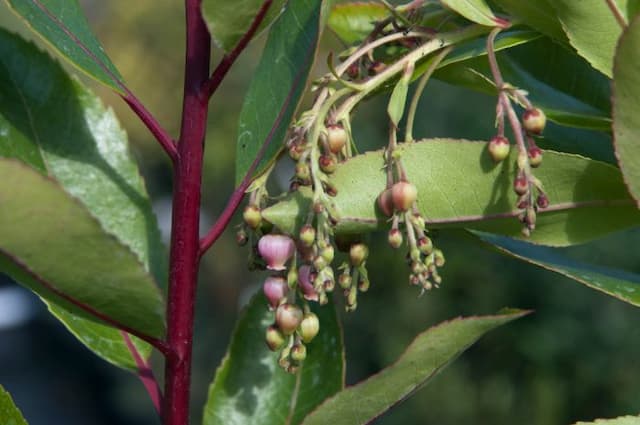Cornish Heath Erica vagans 'Birch Glow'










ABOUT
The Erica vagans 'Birch Glow', commonly known as the Cornish heath, is an ornamental plant valued for its attractive foliage and blooms. The plant features needle-like leaves that are a bright green in color, setting a verdant backdrop for its flowers. These leaves are small and provide a dense, bushy appearance. The Cornish heath is particularly noted for its profusion of bell-shaped flowers, which are typically a warm, glowing pink hue. These delicate, clustered blooms give the plant a soft, textured look, and they tend to cover the plant in such a way that they create a stunning, colorful display that can catch the eye from a distance. The blossoms generally provide a long-lasting show, persisting for an extended period. Though the size of the plant is not to be discussed, it is still appropriate to mention that 'Birch Glow' can be used as a ground cover or as part of a border, fitting well into various garden styles. Its overall appearance is one of lushness and vibrancy, and it can provide year-round interest due to its evergreen nature, making it a favored choice for gardeners looking to add ongoing color and texture to their landscapes.
About this plant
 Names
NamesFamily
Ericaceae
Synonyms
Cornish Heath, Wandering Heath
Common names
Erica vagans 'Birch Glow'.
 Toxicity
ToxicityTo humans
Cornish heath is generally considered non-toxic to humans. As such, there is no well-documented toxicity or symptoms of poisoning associated with ingestion of this plant. While it is not advisable to consume any plant material without certainty of its safety, ingestion of Cornish heath is unlikely to cause harm. However, as with any plant, individual allergies or sensitivities are possible, and it is always recommended to exercise caution and avoid ingesting plants not intended for consumption.
To pets
Cornish heath is not known to be toxic to pets. There are no significant symptoms of poisoning expected if a pet ingests parts of this plant. While the plant is considered non-toxic, it is always best to prevent pets from eating ornamental plants as they can cause gastrointestinal upset or an allergic reaction in some animals. If you suspect your pet has ingested a large amount of any plant material and is showing adverse symptoms, contact your veterinarian.
 Characteristics
CharacteristicsLife cycle
Perennials
Foliage type
Evergreen
Color of leaves
Green
Flower color
Pink
Height
1 feet 6 inches (45 cm)
Spread
2 feet (60 cm)
Plant type
Shrub
Hardiness zones
5
Native area
Europe
Benefits
 General Benefits
General Benefits- Attracts Pollinators: Erica vagans 'Birch Glow' is known to attract bees and butterflies, which are important for pollinating other plants in the garden.
- Low Maintenance: Once established, this plant requires minimal care and is relatively drought resistant, making it ideal for gardeners seeking low-maintenance options.
- Evergreen Foliage: The plant retains its foliage year-round, providing consistent color and texture to the garden landscape even in the winter months.
- Long Flowering Season: With a long blooming period from midsummer to early autumn, it adds vibrant color to gardens for an extended time.
- Soil Adaptability: Erica vagans 'Birch Glow' can adapt to a wide range of soil types, although it prefers well-drained, acidic soil.
- Erosion Control: Its root system helps stabilize the soil, making it an excellent choice for slopes or areas prone to erosion.
- Compact Size: It is a compact shrub suitable for small gardens, borders, or as part of a mixed planting scheme.
- Tolerance to Harsh Conditions: This species can withstand coastal conditions and is resistant to salt spray, making it suitable for seaside gardens.
- Ornamental Value: With its attractive pinkish flowers and dark green foliage, it is widely used for ornamental purposes in various landscaping designs.
- Habitat Creation: It provides shelter and habitat for small wildlife, contributing to the biodiversity of the garden ecosystem.
 Medical Properties
Medical PropertiesThis plant is not used for medical purposes.
 Air-purifying Qualities
Air-purifying QualitiesThis plant is not specifically known for air purifying qualities.
 Other Uses
Other Uses- Floral Arrangements: Erica vagans 'Birch Glow', commonly known as Cornish heath, can be used in dried floral arrangements to add texture and a soft glow to the composition.
- Nature Photography: Its attractive form and flowers make Cornish heath a great subject for nature photography, especially in wild heathland settings.
- Artistic Inspiration: The delicate structure and coloration of Cornish heath can serve as inspiration for artists and designers in various media, including watercolor, textile design, and landscape paintings.
- Craft Projects: The stems and flowers can be incorporated into craft projects like making eco-friendly greeting cards or bookmarks.
- Education: Cornish heath being native to certain regions, it can be used in educational settings to teach students about local flora and conservation efforts.
- Themed Gardens: It is suitable for creating themes in gardens, such as fairy or miniature gardens, where it adds an enchanting touch.
- Bonsai Practices: With careful pruning, Cornish heath can be cultivated as a Bonsai plant, exemplifying the heathlands in a miniature form.
- Erosion Control: It can be used in landscaping to help control erosion on slopes due to its mat-forming growth habit.
- Wildlife Habitat: Planting Cornish heath can provide a natural habitat for insects, especially bees, which are attracted to its flowers.
- Culinary Garnish: While not commonly consumed, the flowers could be used as a unique, non-toxic garnish for special dishes or desserts.
Interesting Facts
 Feng Shui
Feng ShuiThe Heather is not used in Feng Shui practice.
 Zodiac Sign Compitability
Zodiac Sign CompitabilityThe Heather is not used in astrology practice.
 Plant Symbolism
Plant Symbolism- Independence: The Erica vagans, commonly known as Cornish heath, is known for its ability to thrive on poor, rocky soils, symbolizing resilience and the ability to stand strong independently.
- Adaptation: Cornish heath adapts well to its environment, representing versatility and the ability to succeed in various conditions.
- Survival: As a plant that can tolerate and survive harsh conditions, Cornish heath is a symbol of enduring life and survival against odds.
- Beauty: With its delicate pink flowers, the Cornish heath signifies beauty and appreciation for the subtle delights in life.
- Solitude: Often found standing alone in its natural habitat, this plant can be a symbol of solitude and contemplation.
 Water
WaterThe Cornish Heath should be watered thoroughly, allowing the soil to dry slightly between waterings. Aim to provide about one gallon of water per week, adjusting for rainfall and temperature, as they will require more water during hot, dry periods and less during cooler, rainy seasons. It's important to avoid waterlogging the soil, as this can lead to root rot, so ensure good drainage.
 Light
LightCornish Heath thrives in full sun to partial shade. The best spot for this plant is one where it receives at least four to six hours of sunlight daily, although it can tolerate some light afternoon shade, especially in hotter climates.
 Temperature
TemperatureCornish Heath can survive in a range of temperatures but prefers a cooler climate, with ideal temperatures between 60 and 70 degrees Fahrenheit. It can survive minimum temperatures down to around 10 degrees Fahrenheit but may struggle in temperatures exceeding 75 degrees Fahrenheit for prolonged periods.
 Pruning
PruningPrune Cornish Heath mainly to maintain its shape and encourage bushy growth. The best time to prune is immediately after flowering, typically in late spring or early summer. Remove dead flowers and any dead or damaged branches, cutting back to healthy wood.
 Cleaning
CleaningAs needed
 Soil
SoilCornish heath 'Birch Glow' thrives in well-drained, acidic soil with a pH between 4.5 and 5.5. A mix of peat, sand, and loamy soil in equal parts is ideal to ensure proper drainage and root health.
 Repotting
RepottingCornish heath 'Birch Glow' typically requires repotting every 2 to 3 years. The best time to repot is in the spring before new growth starts.
 Humidity & Misting
Humidity & MistingCornish heath 'Birch Glow' prefers moderate humidity levels, not too dry or too moist, to thrive.
 Suitable locations
Suitable locationsIndoor
Place in bright indirect light; water when topsoil feels dry.
Outdoor
Full to partial sun, shelter from harsh winds, and well-draining soil.
Hardiness zone
6-8 USDA
 Life cycle
Life cycleErica vagans 'Birch Glow', commonly known as Cornish heath 'Birch Glow', starts its life cycle as a seed which germinates in well-draining, acidic soil, typically in spring. Seedlings develop into young plants, forming a woody base with needle-like foliage. As the plant matures, it reaches its full size and bushy form, characterized by dense, dark green leaves. During late summer to early fall, it blooms with pink to purple flowers, attracting bees and butterflies. After pollination, flowers develop into small seed capsules, which eventually open to release seeds for the next generation. During winter, the plant may remain evergreen, although in harsh climates it may lose some foliage but will recover in the following spring.
 Propogation
PropogationPropogation time
Late summer
Propogation: The Cornish heath, scientifically known as Erica vagans 'Birch Glow', is commonly propagated through semi-ripe cuttings. This is best done in the late summer, when growth for the year is beginning to mature but hasn't yet turned fully woody. Snip a 2 to 4-inch (5 to 10 cm) length of stem that does not have flowers. Strip the leaves from the lower half of the cutting and dip this end into a rooting hormone powder to encourage root development. Then, plant the cutting in a pot filled with a mix of half peat and half coarse sand or a perlite mixture, ensuring that the leafless part of the stem is buried. The pot should be placed in a propagator or covered with a plastic bag to maintain humidity, and kept in a warm place with indirect light until roots develop before transplanting the new plant to its permanent location.
